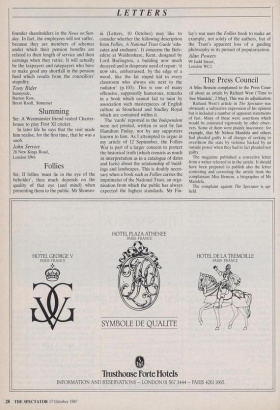Follies
Sir, If follies 'must lie in the eye of the beholder', then much depends on the quality of that eye (and mind) when presenting them to the public. Mr Shomro- ni (Letters, 10 October) may like to consider whether the following description from Follies, A National Trust Guide 'edu- cates and enchants'. It concerns the Belv- edere at Waldershare, Kent, designed by Lord Burlington, a building now much decayed and in desperate need of repair: 'it now sits, embarrassed, by the edge of a wood, like the fat stupid kid in every classroom who always sits next to the radiator' (p.103). This is one of many offensive, supposedly humorous, remarks in a book which cannot fail to taint by association such masterpieces of English culture as Stourhead and Studley Royal which are contained within it.
The 'cards' reported in the 'Independent were not printed, written or sent by Ian Hamilton Finlay, nor by any supporters known to him. As I attempted to argue in my article of 12 September, the Follies War is part of a larger concern to protect the historical truth (which consists as much in interpretation as in a catalogue of dates and facts) about the relationship of build- ings and landscapes. This is doubly neces- sary when a book such as Follies carries the imprimatur of the National Trust, an orga- nisation from which the public has always expected the highest standards. Mr Fin- lay's war uses the Follies book to make an example, not solely of the authors, but of the Trust's apparent loss of a guiding philosophy in its pursuit of popularisation.
Alan Powers
99 Judd Street, London WC1


























































 Previous page
Previous page